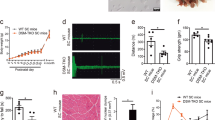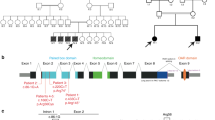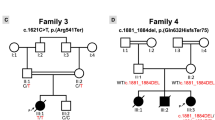Abstract
Myotonic dystrophy, or dystrophia myotonica (DM), is a highly variable multisystem disease in which the classic adult-onset form displays progressive muscle wasting, cataracts, heart block, gonadal atrophy, insulin resistance and neuropsychiatric impairment. Its genetic basis is an expansion of CTG trinucleotide repeats in the DMPK protein kinase gene1–5. Among the triplet repeat expansion disorders, DM is distinguished by the extended length of the repeat tract (5–13 kb in postmortem tissue6,7) and its location in the 3′ untranslated region of the gene that contains it8. The pathophysiological mechanism for multisystem degeneration in DM is not understood. In contrast to the profound muscle wasting that characterizes advanced DM, only minor histopathological abnormalities have occurred in DMPK knockout mice or in mice that overexpress a human DMPK transgene9,10, making it unlikely that changes in DMPK activity provide a unitary explanation for the disease. A DNAse hypersensitive site that maps 0.7 kb downstream (centromeric) from the CTG repeats is eliminated on DM chromosomes11. This finding indicates that the repeat expansion may alter the adjacent chromatin structure and raises the possibility that it may also affect the expression of flanking genes. An interesting candidate flanking gene is DMAHP, a recently discovered homeodomain-encoding gene12. We show here that DMAHP expression in myoblasts, muscle and myocardium is reduced by the DM mutation in as, and the magnitude of this effect depends on the extent of CTG repeat expansion. These observations support the hypothesis that DMAHP participates in the pathophysiology of DM.
This is a preview of subscription content, access via your institution
Access options
Subscribe to this journal
Receive 12 print issues and online access
$209.00 per year
only $17.42 per issue
Buy this article
- Purchase on Springer Link
- Instant access to full article PDF
Prices may be subject to local taxes which are calculated during checkout
Similar content being viewed by others
References
Buxton, J. et al. Detection of an unstable fragment of DNA specific to individuals with myotonic dystrophy. Nature 355, 547–548 (1992).
Aslanidis, C. et al. Cloning of the essential myotonic dystrophy region and mapping of the putative defect. Nature 355, 548–551 (1992).
Harley, H.G. et al. Expansion of an unstable DNA region and phenotypic variation in myotonic dystrophy. Nature 355, 545–546 (1992).
Mahadevan, M. et al. Myotonic dystrophy mutation: an unstable CTG repeat in the 3′ untranslated region of the gene. Science 255, 1253–1255 (1992).
Fu, Y.H. et al. An unstable triplet repeat in a gene related to myotonic muscular dystrophy. Science 255, 1256–1258 (1992).
Ashizawa, T., Dubel, J.R. & Harati, Y. Somatic instability of CTG repeat in myotonic dystrophy. Neurology 43, 2674–2678 (1993).
Thornton, C.A., Johnson, K. & Moxley, R.T. 3rd. Myotonic dystrophy patients have larger CTG expansions in skeletal muscle than in leukocytes. Ann. Neurol. 35, 104–107 (1994).
Brook, J.D. et al. Molecular basis of myotonic dystrophy: expansion of a trinucleotide (CTG) repeat at the 3′ end of a transcript encoding a protein kinase family member. Cell 68, 799–808 (1992).
Reddy, S. et al. Mice lacking the myotonic dystrophy protein kinase develop a late onset progressive myopathy. Nature Genet. 13, 325–334 (1996).
Jansen, G. et al. Abnormal myotonic dystrophy protein kinase levels produce only mild myopathy in mice. Nature Genet. 13, 316–324 (1996).
Otten, A.D. & Tapscott, S.J. Triplet repeat expansion in myotonic dystrophy alters the adjacent chromatin structure. Proc. Natl. Acad. Sci. USA 92, 5465–5469 (1995).
Boucher, C.A. et al. A novel homeodomain-encoding gene is associated with a targe CpG island interrupted by the myotonic dystrophy unstable (CTG)n repeat. Hum. Mol. Genet. 4, 1919–1925 (1995).
Kawakami, K., Ohto, H., & Saito, T. Identification and expression of sixfamily genes in mouse retina. FEBS Lett. 393, 259–263 (1996).
Neville, C.E., Mahadevan, M.S., Barceló, J.M. & Korneluk, R.G. High resolution genetic analysis suggests one ancestral predisposing haplotype for the origin of the myotonic dystrophy mutation. Hum. Mol. Genet. 3, 45–51 (1994).
Krahe, R. et al. Effect of myotonic dystrophy trinucleotide repeat expansion on DMPK transcription and processing. Genomics 28, 1–14 (1995).
Wang, Y.H., Amirhaeri, S., Kang, S., Wells, R.D. & Griffith, J.D. Preferential nucleosome assembly at DNA triplet repeats from the myotonic dystrophy gene. Science 265, 669–671 (1994).
Wang, Y.H. & Griffith, J. Expanded CTG triplet blocks from the myotonic dystrophy gene create the strongest known natural nucleosome positioning elements. Genomics 25, 570–573 (1995).
Godde, J.S. & Wolffe, A.P. Nucleosome assembly on CTG triplet repeats. J. Biol. Chem. 271, 15222–15229 (1996).
Wang, J. et al. Myotonic dystrophy: evidence for a possible dominant-negative RNA mutation. Hum. Mol. Genet. 4, 599–606 (1995).
Taneja, K.L., McCurrach, M., Schalling, M., Housman, D. & Singer, R.H. Foci of trinucleotide repeat transcripts in nuclei of myotonic dystrophy cells and tissue. J. Cell Biol. 128, 995–1002 (1995).
Kawakami, K., Ohto, H., Ikeda, K. & Roeder, R.G. structure, function and expression of a murine homeobox protein AREC3, a homologue of Drosophila sine oculis gene product, and implication in development. Nucl. Acids Res. 24, 303–310 (1996).
Blau, H.M. & Webster, C. Isolation and characterization of human muscle cells. Proc. Natl. Acad. Sci. USA 78, 5623–5627 (1981).
Ciaraldi, T.R., Abrams, L., Nikoulina, S., Mudaliar, S. & Henry, R.R. Glucose transport in cultured human skeletal muscle cells: regulation by insulin and glucose in nondiabetic and non-insulin-dependent diabetes mellitus subjects. J. Clin. Invest. 96, 2820–2827 (1995).
Author information
Authors and Affiliations
Rights and permissions
About this article
Cite this article
Thornton, C., Wymer, J., Simmons, Z. et al. Expansion of the myotonic dystrophy CTG repeat reduces expression of the flanking DMAHP gene. Nat Genet 16, 407–409 (1997). https://doi.org/10.1038/ng0897-407
Received:
Accepted:
Issue Date:
DOI: https://doi.org/10.1038/ng0897-407
This article is cited by
-
Polypoidal choroidal vasculopathy in a patient with DMPK-associated myotonic dystrophy
Documenta Ophthalmologica (2022)
-
Dosage effect of multiple genes accounts for multisystem disorder of myotonic dystrophy type 1
Cell Research (2020)
-
The C9orf72 repeat expansion itself is methylated in ALS and FTLD patients
Acta Neuropathologica (2015)
-
Choroidal new vessels in type 1 myotonic dystrophy-related macular dystrophy respond to anti-VEGF therapy
Eye (2012)
-
RNA steady‐state defects in myotonic dystrophy are linked to nuclear exclusion of SHARP
EMBO reports (2011)



